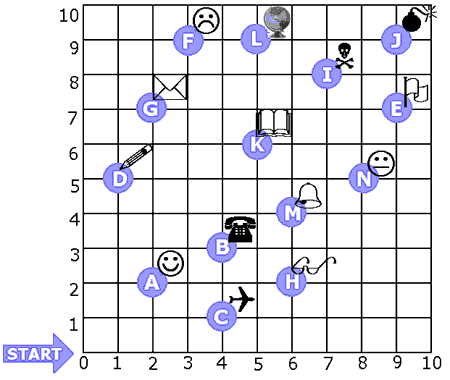|
Who can play:
Students of standard VI and VII.
Materials required:
1. Game board
2. 2 dice, one with dots, representing the ‘x’ co-ordinate and the other with numbers, representing the ‘y’
co-ordinate.The dots and numbers range from 1 to 6, as shown in the figure.
3. 2 counters for the players to play.
4. 14 card board strips of dimension (5cm x 10cm) – The matter- Question Cards-
is to be written on these cards.
About the game board:
The game board has a rectangular co-ordinate system drawn. On it, 14 points are named using letters A to N.
The information regarding each letter is also given.
How to play:
1. Stack all the cards in order.
2. Keep both your counters at 0,0 (‘Start’ point)
3. After deciding who starts to play first, throw both the dice simultaneously and move the counters accordingly.
For example:
If you get,  place your counters at (3, 4) place your counters at (3, 4)
If you get,  place your counters at (2, 2) place your counters at (2, 2)
4. Now, at (2,2) you have a letter ‘A’. Refer the letter code and act accordingly. Read
A’s description and answer the question. If you answer the question correctly, you get one more chance to play. If you fail to answer the question correctly, miss a turn.
5. If you are already on a point and you get the dice readings as (5,3) for example, move further accordingly.
6. The player who reaches (10,10) first is the winner.
Rules of the game:
1. If you move to a location, as per the readings on the dice, but find that your friend’s counter is already there on that location, you will have to move back your counter to (0,0), the starting point.
2. You cannot exceed the location (10,10). It is necessary that you get the exact readings to reach there. In case you do not get the appropriate readings, you stand to miss a turn.
3. If a situation arises where only your x-co-ordinate or only your y-co-ordinate happens to be 10, you have to come back to the starting point (0,0) and start all over again.

|
|
Question Cards
| A |
What is the name of the quadrilateral whose sides are 2 units each ? |
| B |
What numbers must you obtain on the dice in order to reach the point M from here? |
| C |
What is the name of the quadrilateral whose sides are 4 units and 1unit? |
| D |
How much more must you get on the numbered dice (y-value) to reach the point G? |
| E |
Name the geometrical figure that will be obtained when the points K, L, J, E, N and K are joined in order, by line segments. |
| F |
What would be the maximum number that would appear on the dotted dice (x - value)? Will it help you to reach the winning tower? |
| G |
Name two more objects in the shape you find at point L |
| H |
How far is the winning tower from the start? |
| I |
What numbers must appear on the dice to reach the winning tower from here? |
| J |
If you get the numbers (2, 2) on the dice now, will it help you to reach the winning tower? If not what do you have to get on your dice? |
| K |
How much more must you get on the dotted dice (x-value) to reach the point E? |
| L |
Which geometrical figure does the picture resemble? |
| M |
Name the geometrical figures that will be obtained when a diagonal is drawn across a regular hexagon |
| N |
Name the geometrical figure that will be obtained by joining the points A, B, M and N |
ANSWERS TO QUESTIONS OF THE ‘COORDINATE GAME’:
| CARD |
ANSWER |
CARD |
ANSWER |
| A |
Square |
H
|
It
is far by (10,10)
|
| B |
(2,1) |
I |
(3,2) |
| C |
Rectangle |
J |
No,
(1,1) |
| D |
2 |
K |
4 |
| E |
Pentagon |
L |
Sphere |
| F |
6, No |
M |
Trapeziums |
| G |
Answers vary |
N |
Line-segment |
|
(Ex. Ball,
Laddoo) |
|
|
|